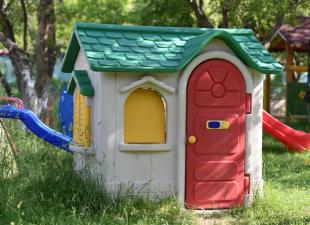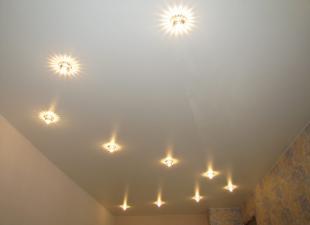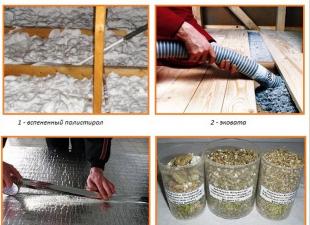One of the most popular finishing options today is painting with water-based paint. But sometimes this finish is complicated by the presence of old paint. This article will tell you what you need to do in order to paint the ceiling with the old finish.
Today, painting the ceiling with water-based paint is considered the most preferred and popular option. The times when a variety of chalk and lime mortars were used for finishing are a thing of the past. Therefore, at the moment, the coloring compositions are characterized by a significant variety. The assortment of water emulsioka, as one of the most popular types, is also quite large today. As a result, the process of painting the ceiling surface in the presence of an old layer should begin with the selection of a suitable finishing material.
Today, water-based paint is represented by the following compositions:
- Acrylic. These are the most common formulations today. They are characterized by high performance characteristics, as well as gradation according to various types of premises. Therefore, among them, each person will find the best option. The cost of acrylic compounds will be slightly higher than the average among the offers of the paint and varnish market segment.
- Latex. These compositions fit perfectly on a variety of surfaces. In this case, the resulting finish is perfectly washable. The only drawback of such compositions is the cost, which will be many times more than that of other products.
- Silicate. Such products are based on liquid glass. An excellent basis for silicate compositions is a stone or concrete surface. At the same time, they are most often used for decoration in industrial premises, but silicone compounds are used extremely rarely for home. A feature of such paints is that they have elasticity, moisture resistance, and can also mask cracks up to 2 mm. But their value is higher than the average market price.
- Polyvinyl acetate. This finish cannot be washed, as the material has a low moisture resistance. Therefore, it can be applied to the ceiling only in dry rooms.

As you can see, the range of paints and varnishes is quite extensive and is able to satisfy any requirements. Therefore, before buying a finishing material, it is necessary not only to know the parameters of the room where the repair will be carried out, but also to study in detail the possibilities of the existing coloring compositions. But many experts recommend giving preference to a coating that can be washed after being applied to the ceiling. Such compositions will allow you to keep the surface clean, and not to make repairs every time in order to renew.
Preparation
If you decide to refresh your ceiling with a new coloring composition, then for the success of painting work, you should carry out high-quality preparation. Even if the surface finish is to be carried out with water-based paint, the old finish, whatever it may be, must be cleaned off. This is due to the following reasons:
- the paint layer has already lost its former attractiveness;
- cracks appeared on the ceiling, due to which, after applying a new layer of finish to the surface, a collapse is possible;
- mold may well develop under the old finish, which will lead to the fragility of the repair.

Removing the old layer of water-based paint from the ceiling surface is carried out as follows:
- We wet the old coating abundantly with water. To do this, you can use a hand sprayer or roller.
- Then we leave the surface for some time for better soaking.
- After 20 minutes, repeat the wetting procedure. In this case, windows and doors must be open.
- After about 30 minutes, bubbles will appear on the ceiling. We take an iron spatula and scrape off the old coating.
After removing the remaining finish, the surface must be thoroughly rinsed with clean water. To do this, you need to use a foam sponge. If there are defects in the starting surface (cracks, potholes, etc.), they should be covered with putty. When it dries, smooth the surface with sandpaper or sandpaper.
For putty, many experts advise choosing universal polymer compositions. They are, of course, more expensive than cement or gypsum, but it will be much easier for beginners to work with them.

Please note that in the presence of strong surface drops, it is not recommended to do it yourself to eliminate this kind of defect. To do this, it is better to call an experienced plasterer or install suspended ceiling structures.
If the differences are no more than 3 mm, then there are two alignment options:
- Plastering in the right places. For these purposes, you must constantly use the level.
- Using ceiling tiles. It can be painted very easily and quickly with water-based paint. At the same time, you can choose a different decorative pattern with the help of such plates.
After all the above manipulations, in order for the painting to be successful, the prepared surface must be primed. The priming process itself is not difficult. But if it is not carried out, in the future, the final finish may become stained, which will ruin its aesthetic appearance.
For priming, use professional solutions that have deep penetration. In this case, for a greater effect, the primer should be applied in several layers. It will be enough to prime it twice.

Some people, in order not to spend money on buying a primer, prepare it with their own hands. For these purposes, a purchased water-based paint is suitable, which is simply diluted with water. By the way, any composition fits perfectly on itself, even in a diluted form.
Separately, it should be noted that after removing the unfit finish, mold may be exposed. To combat it, special antiseptics should be used. They not only destroy existing mold, but also prevent its appearance in the future.
Instead of expensive antiseptics, you can also use self-prepared solutions (for example, a five percent solution of copper sulfate). The treatment should be done after removing the old finish and before applying a putty or primer.
Having done the above manipulations correctly and consistently, you will properly prepare for painting.
Staining technique
The staining technique includes two important steps:
- choice of tools for painting;
- painting of a previously prepared surface.
Let's consider each stage in more detail.

Painting ceilings always starts with choosing a tool. Painting can be done with the following tools:
- Brushes. In order to effectively paint any surface, you need to use brushes of different sizes. It should be noted that brushes are not very effective for large areas of work. At the same time, they do not allow the coloring composition to be applied in an even and thin layer. They can be used for high-quality paint over various decorative convex finishing elements, as well as the joints between the walls and the ceiling.
- Roller. It is considered the most effective tool, but only with the right selection. The dimensions of the selected roller directly depend on the area of painting. The larger the area, the thicker and longer the roller should be. In this case, you need to pay attention to the material from which the roller skin is made. Different skins work for different colors. For work with water-based compositions, you should choose velor skins and those that have a long pile. Also, for work with the ceiling, it is necessary to choose products with a long handle. It will allow, being on the floor, to effectively carry out painting work without using a ladder.
- Professional spray gun. This tool costs significantly more than a roller and brush. In addition, not every person can cope with it.

Experts recommend using a roller for painting, since it can be used to quickly and efficiently apply an even coating over fairly large areas. But brushes in this situation will still be needed to paint over the corners. Please note that the ink tray should be selected depending on the size of the purchased roller.
Do not forget that you need to apply a water-based emulsion only when the base is completely dry after priming.
Painting the ceiling with water-based paint is carried out according to the following algorithm:
- We open a can of paint and mix it well, touching the lower layers. This must be done in order to obtain a uniform color of the composition.
- Next, pour the paint into the tray.
- First, you should paint over the corners and all the places that are inaccessible to the roller. For this we use a brush.
- After that, dip the roller into the poured composition.
- On the embossed area of the tray, we wring out the roller so that paint does not drip from it. As a result, the composition is evenly distributed over the surface of the roller.
- The first layer should be applied parallel to the direction of the natural lighting in the room. One place should be rolled several times to avoid dark spots and sagging. Painting is done with an overlap on the previous strip. Moreover, the entry should be half the size of the roller. It is best to make a W-shaped movement.

 parlini.ru Repair of an apartment, a summer residence and a house.
parlini.ru Repair of an apartment, a summer residence and a house.


